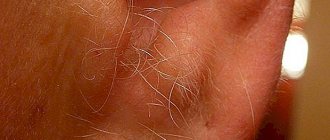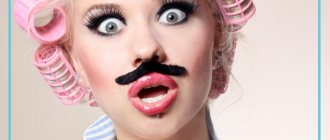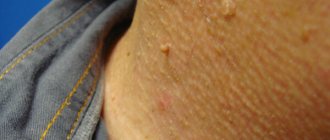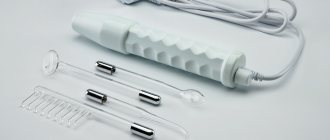Services Doctors Results Reviews
Expert tested
Sharubina Karina Petrovna Trichologist, dermatovenerologist, cosmetologist
Publication date: October 10, 2022
Review date: November 16, 2022
Although on average there are about 140 thousand hairs on the head, the norm for daily natural hair loss is considered to be from 50 to 100 hairs. Of course, none of us will count the hairs remaining on the brush, but if visually there are a lot of them left after combing, you need to urgently take action - start professional treatment with a trichologist.
There are several types of hair and scalp problems:
- hair loss (alopecia);
- the appearance of dandruff and seborrhea;
- degeneration of hair shafts (breakage, thinning of hair, appearance of split ends);
- fungal infections.
Why do my hair and scalp hurt?
Even if your hair begins to noticeably fall out, you should not immediately panic and assume that this is a consequence of some serious illness.
As a rule, hair problems begin due to frequent stressful situations, poor environment, unbalanced diet, hormonal imbalance in the body, various infections or too much enthusiasm for hair cosmetics, as well as various dyes or chemicals for curling or straightening.
Sharubina Karina Petrovna
Trichologist, dermatovenerologist, cosmetologist
With nervous exhaustion, overwork, and depression, hair becomes brittle and dry, and dandruff appears. Dryness is caused by decreased function of the sweat and sebaceous glands. Hair also becomes brittle and dry due to decreased levels of hormones in the blood and poor nutrition. Severe stress can affect the development of “focal” (“cluster”) baldness, when round-shaped areas devoid of hair appear on the skin.
Hair can also fall out in clumps when the body is intoxicated. But increased oiliness of hair is caused by the use of large amounts of fatty nourishing oils and masks.
What scalp diseases lead to hair loss?
Seborrhea
(peeling) appears due to dysfunction of the sebaceous glands. With oily seborrhea, the sebaceous glands are overactive; with dry seborrhea, on the contrary, skin sensitivity is observed. In both cases, seborrhea is accompanied by dandruff and itching.
Furunculosis
- inflammation of the hair follicles and sebaceous glands - is caused by staphylococcus bacteria, which can penetrate the scalp through microcracks.
Mycosis
- fungal disease. It is accompanied by itching, the formation of pustules, and darkening of the scalp. With mycosis, areas of baldness appear on the head.
Alopecia
(baldness) occurs due to various reasons, which can be divided into two types: external (frequent stress, infectious diseases, trauma and damage to the surface of the head); internal (hormonal imbalances, metabolic disorders, predisposition at the gene level (heredity).
Physical examination
An examination of the scalp will show whether there is a visible reduction in the amount of hair (alopecia) and, if so, of what nature. Inflammatory erythema or scaling should be noted, as psoriasis and eczema can cause effluvium (e3). Dermatoscopy of the scalp is also useful (5). The clinical hair pulling test is complemented by a tricho(rizo)gram, in which 20–50 hairs are epilated with a rubberized hemostat and then analyzed under a microscope. Thus, it is possible to count roots of varying degrees of maturity in each growth phase. A percentage of telogen phase hair greater than 20% indicates increased hair loss (6, e4). Non-invasive phototrichogram can also assess the anagen to telogen ratio (e5), but cannot detect root abnormalities such as hair dystrophy.
Features of hair loss in men
Male pattern baldness is called androgenetic or androgenetic. It also occurs in women, but is quite rare.
Androgenetic type of baldness is caused by hormonal imbalances in the body. Moreover, in men, loss is associated not so much with a drop in testosterone levels, but with its active metabolite - dihydrotestosterone. It is released (under the action of an enzyme) in the follicle, causing premature hair loss.
The cause of baldness may also be a genetic predisposition.
This type of baldness is localized in the frontoparietal and vertex regions. The temporal and occipital areas are practically not affected.
Androgenic type of baldness appears gradually. The process, as a rule, begins with the hair thinning, becoming brittle, and growing more slowly. Then bald patches begin to appear. In representatives of the stronger sex, they are located on the crown or frontal areas.
In addition, the process of hair loss on the head is often accompanied by increased growth of facial hair, the appearance of acne and oily seborrhea.
If you do not start timely treatment for hair loss, it will be extremely difficult to stop baldness: hair will begin to quickly fall out both in the frontoparietal and vertex areas.
Diagnosis of dermatitis
In the An-Tek Laboratory, before treatment of skin dermatitis, the patient undergoes diagnostics. A trichologist will evaluate the condition of the skin on the head, the features of its scalp, and use a trichoscope to study the structure of the hair, its thickness and other characteristics. With seborrhea, a clinical picture is enough to make a diagnosis: when prescribing treatment, the doctor will make sure that the patient really has seborrhea, and not other diseases with similar symptoms - rosacea, lichen, psoriasis, eczema and others.
The first recommendation to the patient is to use a special shampoo for the head, indicated for the treatment of seborrhea and dermatitis. However, this remedy alone may not be enough to return the skin to its normal state. In this case, the doctor will resort to active general treatment. Seborrhea responds well to the use of local remedies, but an integrated approach is always more effective.
Features of hair loss in women
Female pattern baldness is called diffuse or uniform. Hair loss in women occurs all over the head. And it starts from the vertex and frontoparietal zones.
At the same time, hair loss in women does not create bald patches - the front hairline is preserved. If you don’t start treatment after your hair starts to fall out rapidly, then in a couple of years it will thin out very much all over your head. And after 10-15 years, without proper therapy, complete hair loss can occur.
Hair loss in women can occur either actively or gradually.
Hair loss in a woman can be: telogen effluvium (the most common type, the cause of which is that 80% of follicles (hair follicles) go into “dormant form” ahead of schedule due to chronic diseases or damage to the endocrine system); anagen form (this type of hair loss occurs due to exposure to aggressive environmental factors, and the follicles may completely die).
Other common causes of hair loss in women include: hormonal imbalance; postpartum period; toxic effects; iron deficiency; exposure to fungi or microbes; problems with immunity; frequent dyeing, perm.
What is a fungus
A group of microorganisms that parasitize the skin and its stratum corneum (hair and nails) are called dermatomycetes, or dermatophytes. They readily master keratin-containing substances.
Mushrooms are essentially heterotrophs, that is, they use ready-made organic substances for their nutrition. Their digestion is external. This means that all waste products of fungi end up on the skin and mucous membranes of humans. Forming entire colonies, they penetrate the epidermis and provoke inflammation. In this case, healthy cells die, including the hair follicle, which often cannot be restored after successful treatment.
Hair loss treatment
Before starting therapy, it is important to identify the exact cause of baldness.
Baldness treatment
selected individually based on diagnostic results. The sooner therapy is started, the higher its effectiveness will be.
Hair and scalp are treated using special procedures and drug therapy, which includes drugs aimed at reducing the sensitivity of the follicles and restoring them.
Proper balanced nutrition, which includes all the necessary vitamins and microelements, is also important.
Among the most effective procedures are the following.
Plasma therapy (PRP therapy)
Shown
: For hair loss, dry and oily seborrhea, fungal infections of the scalp, thinning hair, dull color, increased hair fragility.
The method is similar to Mesotherapy
, only the injectable drug is not therapeutic cocktails, but platelets, which are obtained from a small amount of blood taken from the patient.
The resulting concentrate contains 4-5 times more platelets compared to the starting material taken from the patient. It is injected into areas of the scalp where hair loss is noticeable. The administered drug begins to work instantly. Penetrating into the skin, blood cells - platelets - begin to have a strengthening effect. After this procedure, the hair follicles begin their work with renewed vigor, which leads to active hair growth. When treating baldness, the main thing, as you know, is not to miss the moment when the hair follicle itself is still alive, since new hair grows from the same follicle as the old one. Therefore, PRP therapy
recommended for patients who have begun to lose hair or have encountered the problem of alopecia relatively recently.
The procedure activates the mechanism of intercellular metabolism, enhances the synthesis of useful substances, which is why the hair becomes thicker and stronger within a few weeks. In addition, PRP therapy helps eliminate dandruff and perfectly relieves inflammation. As a result of treatment, hair acquires a healthy shine, becomes more elastic, thicker, and its structure is restored. Hair stops splitting.
Placental therapy
Shown
: For hair loss. To enhance their growth.
Preparations based on the hydrolyzate of human placenta (primarily Japanese Laennec), which are administered intravenously, intradermally, at biologically active points, stop hair loss and activate their growth. The hair on the placenta is alive and shiny.
In addition, Placental therapy is a complex effect on the body. After all, the condition of the hair is a reflection of the internal processes occurring in the body.
Unlike most modern medicines, Laennec has a therapeutic effect without causing side effects or causing harm to the body. Such drugs are called “smart” or “intelligent”, since they themselves find disturbances, as well as points of imbalance, and have an optimal targeted effect to restore balance and optimize the parts of the body system.
The drug contains more than 50 water-soluble components, including: 18 amino acids; mucopolysaccharides necessary for the construction of connective tissues; nucleic and organic acids, nucleosides that enhance protein biosynthesis; vitamins B2, B3, C, D, PP, which provide the antioxidant effect of the drug and are catalysts for metabolic processes; minerals (zinc, magnesium, iron, manganese, copper, selenium, etc.), which are involved in the construction of the skeleton and the formation of hemoglobin, regulate the exchange of vitamins and hormones; Pohormone DHEA is the ancestor of the missing hormone at the physiological level - progesterone, estrogens or testosterone.
The components of the drug Laennec introduced into the scalp penetrate into the foci of pathology and eliminate them, restoring the immune system and mobilizing the body's defenses.
Mesotherapy
Shown
: Prevents hair loss and improves its general condition, helps fight premature gray hair.
Special therapeutic cocktails are injected into the scalp. In other words, there is a direct delivery of medicinal drugs directly to the hair follicle. The cocktails contain various substances that nourish the hair follicle, improve its blood supply and oxygen supply.
Most often, cocktails consist of zinc, selenium, vitamin B, and amino acids. Vitamin B helps get rid of dandruff, strengthens the hair follicle and normalizes the functioning of the sebaceous glands.
Zinc and selenium play an important role in skin regeneration processes and promote hair growth. All these substances beneficial to the body help stop the process of graying and restore the natural color of the hair.
In addition, the injection itself matters. Because the area between the upper and middle layers of the skin, where the germ cells are located, is mechanically irritated. They are encouraged to be active.
One of the causes of hair loss is poor blood supply to the cervical spine. Because of this, hair follicles receive insufficient amounts of vitamins, microelements, and oxygen. Therefore, if the patient is already experiencing loss or this process is just beginning, mesotherapy cocktails are administered not only to the scalp, but also to the cervical-collar area.
Mesotherapy
normalizes blood microcirculation. Blood supply in the cervical spine is normalized.
Microcurrent therapy
Shown
: With hair loss, deterioration of its structure, which leads to the thinning of each hair shaft. Suitable for reducing oily scalp.
The essence of the method is that the scalp is exposed to pulsed currents of low frequency. To carry out Microcurrent therapy, Biogenie Capillaire is used - a fundamentally new device developed by the Rene Bouchaud laboratory (the French company founded by Jaqui Bouchaud uses unique developments, all the most advanced that scientists can offer today) for biotherapy. The potential of Biogenie currents, corresponding to the potential of the cell membrane, in combination with individually selected cosmetics, perfectly promotes the growth of the hair follicle.
It is thanks to the low frequency of pulses that microcurrents penetrate deep into the layer of the epidermis, promoting the dilation of blood vessels, improving blood flow, lymph flow, nourishing the skin with oxygen, and activating metabolic processes in the hair follicles. As a result, hair begins to grow faster, acquires a healthy shine and well-groomed appearance. Weak, damaged hair is restored, the secretion of the sebaceous glands is normalized.
Microcurrents, stimulating the metabolic processes of the scalp, promote the removal of harmful substances from the body, tissue regeneration, and a general improvement in hair condition. In addition, the “sleeping” bulbs are awakened.
Microcurrent therapy
– a painless procedure. It is carried out either in areas that are affected by a particular disease, or over the entire surface of the head.
The procedure is very comfortable for the patient and causes only pleasant sensations. It is especially loved by men who, unlike women, tolerate injection techniques worse.
After just one procedure, hair loss is reduced. After the procedure, the hair looks more vibrant and healthy. The scalp begins to breathe.
Laser therapy
Shown
: For diseases of the scalp - psoriasis, atopic dermatitis, neurodermatitis, dysfunction of the sebaceous glands (dryness, oiliness, dandruff). Hair after laser exposure becomes more elastic, dense, and manageable.
Low Level Laser Therapy
approved by the US Food and Drug Administration.
A low-frequency pulsating light beam penetrates deep under the surface of the skin to the very hair roots - to a depth of 6-8 mm. The energy generated by laser radiation increases the level of blood circulation in the scalp, supplying it with oxygen and increasing the level of metabolism in cells.
At the same time, approximately 70% of hair moves from the resting phase to the growth phase. As a result, 90% of patients stop losing hair, and 50% experience significant hair growth. During therapy, the quality of thinning hair also changes: it thickens and acquires a healthy shine. Renewing blood flow can also be a means of solving problems such as itching, dandruff, hypersecretion of the sebaceous glands, which are also causes of hair loss.
Table of contents
- Seborrheic dermatitis and dandruff
- Androgenetic alopecia
- Alopecia areata
- Scarring alopecia
- Diagnostic imaging of hair diseases
Hair diseases are pathologies of hair follicles and/or shafts, leading to disruption of their growth, structure, and function.
In our company you can purchase the following equipment for diagnosing hair diseases:
- FotoFinder dermoscope Vexia (FotoFinder)
- FotoFinder ATBM bodystudio (FotoFinder)
- FotoFinder (FotoFinder)
- Handyscope (FotoFinder)
The most common hair diseases are:
- Seborrheic dermatitis and dandruff
- Androgenetic alopecia
- Alopecia areata
- Scarring alopecia











